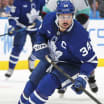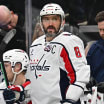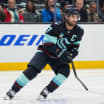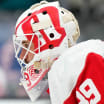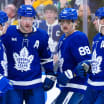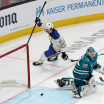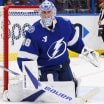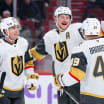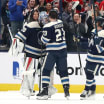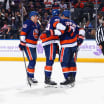Legendary hockey reporter and analyst Stan Fischler will write a weekly scrapbook for NHL.com this season. Fischler, known as "The Hockey Maven," will share his knowledge, brand of humor and insight with readers each Wednesday.
Maple Leafs landing Bentley set standard for lopsided trades in NHL
Fischler lists most uneven exchanges of all time
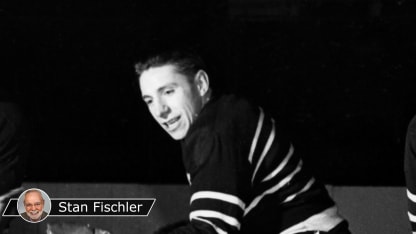
By
Stan Fischler
Special to NHL.com
Some trades seem to make perfect sense. Others are so far-fetched they seem to have been conjured up on Mars.
What looked like an ideal trade developed early in the 1947-48 season between the Toronto Maple Leafs and the Chicago Black Hawks. Each team got what it wanted -- and seemed to need -- at the time.
Conn Smythe, owner and general manager of the defending Stanley Cup champion Maple Leafs, wanted a center who would give his team the best 1-2-3 up-the-middle combination in the NHL. Toronto already had Syl Apps and Ted Kennedy, each a future member of the Hockey Hall of Fame.
The struggling Black Hawks, on their way to an 0-7-0 start and a last-place finish, were desperate for personnel. They not only wanted bodies but proven veterans.
After a week of rumors, the hockey world was shaken by what became the biggest trade of its kind -- and in the end, also unfolded into perhaps the most lopsided one.
Here's how, as well as a few other one-sided exchanges:
Maple Leafs trade five regulars for center Max Bentley (Nov. 2, 1947) -- Never before (or since) has a team delivered an entire forward line plus two experienced defensemen for basically one player.
The Black Hawks owned the apple of Smythe's eye, center Max Bentley. He was Chicago's most popular player and had led the NHL in scoring in 1945-46 and 1946-47. But the offer Smythe put on the table forced Chicago GM Bill Tobin to do a double take.
For offense, there was "The Flying Forts" -- Gus Bodnar, Gaye Stewart and Bud Poile. They had helped Toronto win the Stanley Cup in 1947 and were regarded as one of the best offensive lines in the NHL. Smythe sweetened the pot with defensemen Bob Goldham and Ernie Dickens, who had excelled on Toronto's 1942 Cup-winning team.
In return, Toronto got Bentley (rookie forward Cy Thomas was a throw-in).
Fischler looks back at lopsided trades of the past
On paper, it looked like Chicago won the deal by adding five players who had been part of Cup-winning teams.
But the Maple Leafs got the big prize. Bentley didn't lead the NHL in scoring again, but he was a catalyst as the Maple Leafs won the Cup in 1948, 1949 and 1951. Despite the five newcomers, Chicago didn't make the Stanley Cup Playoffs again until the 1952-53 season; by then, only Bodnar was a regular.
Bruins get Esposito, Stanfield, Hodge from Black Hawks (May 15, 1967) -- Chicago GM Tommy Ivan believed that center Phil Esposito would never be a superstar, nor did he think forward Ken Hodge would be a better-than-average scorer. With that in mind, he sent them along with Fred Stanfield, a young center who he feared would be lost in the upcoming NHL Expansion Draft, to the Boston Bruins, who were coming off their eighth consecutive non-playoff season.
Ivan was hoping that soon-to-be 22-year-old defenseman Gilles Marotte, the biggest piece coming back to Chicago, would become a star and that Pit Martin would emerge as a better-than-average NHL center. Goalie Jack Norris, the third man coming from the Bruins in the trade, was a question mark.
Talk about a one-sided trade.
Esposito blossomed into a record-setting scorer and a Hall of Famer. Hodge scored at least 25 goals in seven of the next nine seasons, including 50 in 1973-74, mostly while playing on Esposito's right wing. Stanfield became an excellent second-line center and was among the most underrated forwards of the 1970s. They helped the Bruins win the Stanley Cup in 1970 and 1972.
Marotte never became the player Ivan was hoping he'd be and was traded less than three years later. Martin was a competent No. 2 center for the next decade. Norris played all of 10 games for Chicago during the next two seasons and didn't play in the NHL after 1970-71.
Bruins get Middleton from Rangers (May 26, 1976) -- Speaking of Esposito: In the spring of 1976, New York Rangers general manager John Ferguson listened too closely to his star center, who had been traded to New York the previous November.
Esposito wasn't happy in New York; he wanted company from his former team, the Bruins. Ferguson succumbed to Esposito's lobbying by acquiring Hodge, his longtime right wing. The price was a young forward named Rick Middleton, who had scored 22 and 24 goals in a limited role during two seasons with New York.
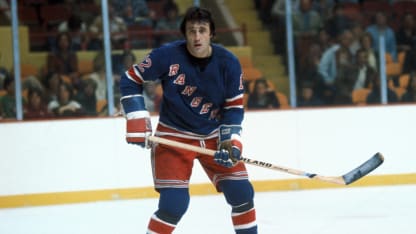
© Icon Sportswire/Getty Images
Boston wound up acquiring Middleton's future (402 goals with the Bruins) for Hodge's past. Hodge played less than two seasons with New York, and by the time Middleton was scoring 103 points for Boston in 1980-81, he had retired after finishing his career in the minors.
Black Hawks get Hall from Red Wings (July 23, 1957) -- Detroit Red Wings general manager Jack Adams was known to make some curious moves. This one cost him dearly.
Adams erroneously blamed young goalie Glenn Hall for an upset loss in the 1957 Stanley Cup Semifinals. He also resented left wing Ted Lindsay for attempting to launch a players' union. Adams traded them to the last-place Black Hawks, who hadn't made the playoffs since 1953, for forwards Johnny Wilson, Forbes Kennedy and Bill Preston, and goalie Hank Bassen.
Wilson, who had played with the Red Wings from 1949-50 through 1954-55 before being traded to Chicago, proved to be an adequate player. Kennedy never had more than 30 points in any of his 11 NHL seasons, Preston never played for the Red Wings and Bassen bounced between the NHL and the minors for most of his career.
Hall became one of hockey's most accomplished goalies, playing an NHL-record 502 consecutive games at one point -- all without a mask. He was at his best in the spring of 1961 when he helped Chicago win the Stanley Cup for the first time since 1938. Lindsay remained an inspirational player and helped Chicago return to the playoffs in 1959. He and Hall are in the Hockey Hall of Fame.
Langway trade sparks turnaround by Capitals (Sept. 9, 1982) -- David Poile, the new general manager of the Washington Capitals, knew Rod Langway was unhappy with the Montreal Canadiens, and he felt the 25-year-old defenseman was just what he needed to help his new team qualify for the Stanley Cup Playoffs for the first time since entering the NHL in 1974. The Capitals acquired Langway along with another young defenseman, Brian Engblom, as well as forwards Craig Laughlin and Doug Jarvis. Going the other way were defenseman Rick Green, the No. 1 pick in the 1976 NHL Draft, and forward Ryan Walter, the No. 2 selection in the 1978 NHL Draft, who was coming off a 38-goal, 87-point season.
Green and Walter were productive for the Canadiens and played on Montreal's Stanley Cup-winning team in 1986. But Langway, who was quickly named captain, became a giant with the Capitals. He won the Norris Trophy in each of his first two seasons and helped Washington begin a 14-season streak of qualifying for the playoffs. Jarvis remained one of the NHL's best defensive forwards for several years, Laughlin scored as many as 30 goals in a season for Washington and Engblom gave the Capitals a solid season on defense before being traded to the Los Angeles Kings for Larry Murphy, who later joined Langway in the Hall of Fame.
Maple Leafs land defenseman Kelly, turn him into center (Feb. 10, 1960) - - Less than two years into his reign as coach and general manager of the Maple Leafs, Punch Imlach traded supposedly gifted defenseman Marc Reaume to Detroit for Red Kelly, a six-time First-Team All-Star defenseman.
In a spark of genius, Imlach took his newly acquired star and played him at center in his first game in a Toronto uniform. Though the Maple Leafs lost, Imlach realized his instincts about playing Kelly in the middle were on target.
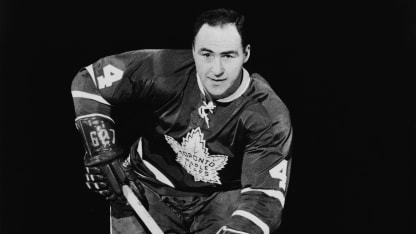
© B Bennett/Getty Images
The line of Kelly with Frank Mahovlich and Bob Nevin became a match made in hockey heaven. Mahovlich scored 48 goals in his first full season with his new linemates. Kelly scored at least 20 goals in each of his first three seasons with Toronto in addition to becoming one of the NHL's best defensive centers. He helped the Maple Leafs win the Stanley Cup four times (1962, 1963, 1964, 1967).
The Red Wings traded Reaume to Hershey of the American Hockey League less than a year later, and he spent most of the next 10 seasons in the minors before retiring.
"It was," Red Wings executive vice president Jim Devellano said years later, "one of the most one-sided trades of all-time. And am I glad I didn't make it!"


